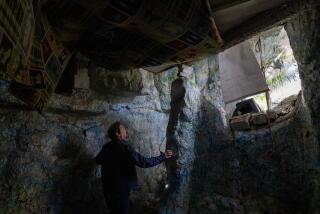La Brea tar pits celebrate a century of stink, ooze and amazement
The La Brea tar pits are marking 100 years of digging history out of the muck.
The aroma of the pits is notorious along Los Angeles’ Miracle Mile, where they have been burbling since prehistoric times. It’s an incredible site that has fascinated scientists for more than a century — the kind of place where construction of an underground parking garage means the discovery of a near-complete adult Columbian mammoth.
They call him Zed.
PHOTOS: Beautiful, bizarre bugs
Those who have visited or live near the pits know the place by its smell — which can approach a freshly tarred road on a hot summer day — and an ooze that has been known to invade the surrounding area. Neighbors in the past have complained of creeping goo during heavy rains.
But the discoveries are the stuff of legend, large and small. The Page Museum has skeletons of dire wolves, sloths and mastodons. It also has a drawer full of saber-toothed kitten remains. The museum is delving into microfossils and what ancient beetle wings and ant legs can tell us about what our world was like tens of thousands of years ago.
Those “tiny bits and pieces ... have become the coolest things on the planet,” Luis Chiappe, a vice president at the Natural History Museum, tells The Times.
One of the first people to see the scientific possibilities in the tar was George Allan Hancock, owner of Rancho La Brea, a former Mexican land grant. In 1913, he gave L.A. County exclusive right to excavate for a two-year period. Then in 1924, he donated 23 acres of the ranch to the county, saying the pits must be preserved and the fossils exhibited.
Those in Los Angeles on Monday can visit the George C. Page Museum for free. Stop by, smell the tar, and appreciate the treasures that were taken from the ooze.
Like fossils and mammoths named Zed? Follow me @AmyTheHub
ALSO:
Common herbicide may be causing frogs to die out
A pacemaker in the brain could help spinal cord injuries







